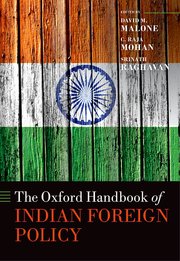In The Oxford Handbook of Indian Foreign Policy, editors David M. Malone, C. Raja Mohan and Srinath Raghavan aim to offer an authoritative and up-to-date survey of foreign policy in India since 1947. Raj Verma writes that, despite some limitations, the book is an essential read for students at all levels and scholars who want to familiarise themselves with India’s foreign policy debates.
This review was originally published on South Asia @ LSE.
The Oxford Handbook of Indian Foreign Policy. David M. Malone, C. Raja Mohan and Srinath Raghavan (eds). Oxford University Press. 2015.
 The inside page of the cover jacket of this book states that ‘Oxford Handbooks offer authoritative and up-to-date surveys of original research in a particular subject area. […] [they] provide scholars and graduate students with compelling new perspectives […].’ The Indian Foreign Policy installment of the series is an excellent attempt at providing an authoritative, compelling and comprehensive (albeit not exhaustive) survey of foreign policy since India gained its independence in 1947. The novelty of the handbook is that contributors straddle different careers, disciplines and countries – academics, practitioners, bureaucrats and diplomats in India and abroad – which provides a range of different perspectives. The blend of academic and policy focus, opinions, debate and discussions offers a wide-ranging analysis of disparate aspects of the South Asian giant’s foreign policy.
The inside page of the cover jacket of this book states that ‘Oxford Handbooks offer authoritative and up-to-date surveys of original research in a particular subject area. […] [they] provide scholars and graduate students with compelling new perspectives […].’ The Indian Foreign Policy installment of the series is an excellent attempt at providing an authoritative, compelling and comprehensive (albeit not exhaustive) survey of foreign policy since India gained its independence in 1947. The novelty of the handbook is that contributors straddle different careers, disciplines and countries – academics, practitioners, bureaucrats and diplomats in India and abroad – which provides a range of different perspectives. The blend of academic and policy focus, opinions, debate and discussions offers a wide-ranging analysis of disparate aspects of the South Asian giant’s foreign policy.
The handbook is structured thematically and in some cases chronologically. It is divided into seven parts which each delve into different facets of India’s foreign policy. Part One discusses the five different approaches to the study of the topic and its theorisation, and correctly concludes that Indian foreign policy is at present under-theorised. Part Two focuses on the evolution of foreign policy, starting with the influence of the British Raj. It then discusses the impact of different prime ministers such as Jawaharlal Nehru, Indira Gandhi, Rajiv Gandhi, Atal Behari Vajpayee and Manmohan Singh among others. Thus it provides a good comparative analysis of and constraints on India’s foreign policy in different time periods. It also has a chapter which illustrates the different nuances of India’s soft power and its applications, and another which provides a good historical background and context to India-China relations and the Tibetan issue.
Part Three discusses the role played by myriad domestic institutions and actors in influencing and implementing foreign policy such as media, bureaucracy, legislature, interest groups, public opinion, diaspora and epistemic community among others. Part Four illustrates the role of geography in influencing and determining India’s foreign policy and its relations in the immediate neighbourhood with China, Pakistan, Afghanistan, Bangladesh and Nepal, and in the near abroad with countries in Southeast Asia, East Asia, West Asia and in the Indian Ocean. Part Five focuses on India’s key partnerships with countries such as Russia, the US, Brazil, Israel, South Africa as well as those of the EU and Africa. Part Six focuses on India’s multilateral diplomacy, discussing India’s role in multilateral organisations and institutions including the UN, UNCTAD, WTO, IMF, World Bank, NPT, CTBT, BRICS and G-20 among others. Part Seven critically analyses India’s quest for great power status and the future trajectory of India’s rise – complete or incomplete due to internal and external constraints. The contributors are pessimistic about India overcoming domestic and external constraints and aver that it would be extremely difficult, if not almost impossible, for India to become a superpower. It might have to contend with being a regional power with external influence or some global influence.
 Image Credit: NASA Earth’s Light (Data courtesy Marc Imhoff of NASA GSFC and Christopher Elvidge of NOAA NGDC. Image by Craig Mayhew and Robert Simmon, NASA GSFC).
Image Credit: NASA Earth’s Light (Data courtesy Marc Imhoff of NASA GSFC and Christopher Elvidge of NOAA NGDC. Image by Craig Mayhew and Robert Simmon, NASA GSFC).
Since the book is structured thematically and chronologically, there is a lot of overlap in some chapters. However, this is acceptable because they can be read as standalone chapters which deal comprehensively with the subject matter at hand. The contributors agree that India’s foreign policy is marred by a lack of coherence and in numerous cases is dogmatic. They also concur that India might be rising and it has global ambitions, but that its policy and behaviour are constrained by self-doubt, burdened ideologies and a lack of vision. To date, India has not been able to provide an alternate vision of the world which might distinguish it from other great or major powers
The handbook suffers from some major and minor errors. It considers the EU, Africa, Latin America and West Asia as monoliths. For example, Chapter 36 is structured thematically and states that the EU is not Europe, but nonetheless excludes non-EU countries without providing a rationale. There is a broad consensus amongst scholars and policymakers that India does not take the EU seriously despite its common security and FP. Instead it prefers to deal with the countries on a bilateral basis. That being the case, the chapter should discuss India’s engagement with major European powers like the UK, Germany and France. Similarly, just one chapter is devoted to India’s engagement with 54 countries in Africa. Although South Africa gets a dedicated chapter, Nigeria, Kenya, Uganda, Mozambique and other countries with which India has significant relations are excluded.
It also suffers from some conceptual errors. Numerous contributors have stated that China and Pakistan are allies, yet no formal alliance exists between them. An alliance implies that in the event of a war between India and Pakistan, China would declare war on India (the same applies in the case of a Sino-Indian war). In Chapter 11, the India-China border dispute and the Tibetan issue are discussed as mutually exclusive issues. However, numerous scholars and policymakers in India, China and the US among other countries opine that the two issues are related and China is wary of resolving the border issue without reconciling the Tibetan issue, lest the latter be used by India to foment and destabilise China once the border issue is resolved.
Despite these limitations, The Oxford Handbook of Indian Foreign Policy is an essential read for students at all levels and scholars who want to familiarise themselves with India’s strategic culture, the role of interest groups and other domestic factors on India’s foreign policy, Indian Ocean, AfPak and emerging Asia. Scholars are encouraged to have this as a core textbook on India’s foreign policy and libraries must have copies of the book.
Dr Raj Verma is Assistant Professor of International Relations and Foreign Policy at the School of International and Public Affairs, Jilin University and Visiting Fellow, Institute for Defence Studies and Analysis, India. Read more reviews by Raj Verma.
Note: This review gives the views of the author, and not the position of the LSE Review of Books blog, or of the London School of Economics.







